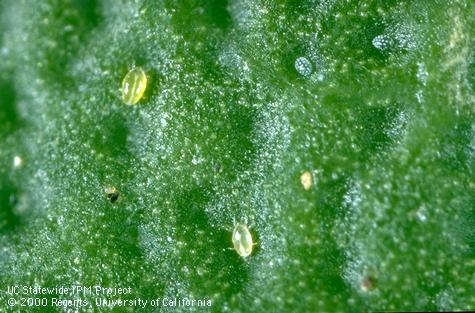
Posts Tagged: broad mite
Predatory Mites Controlling Citrus Broad Mite
We have recently had an outbreak of citrus broad mite (Polyphagotarsonemus latus) in lemons. Broad mites feed on fruit and leaves, preferring young fruit up to about 1 inch (2.5 cm) in diameter that are located on the inside of the canopy or on the inward facing side of outer fruit. Feeding results in scarred tissue that cracks as fruit grows, leaving a characteristic pattern of scars and new tissue. Although most feeding occurs on fruit, broad mites may also feed on young expanding leaves causing them to curl. This cupping and curling of leaves can appear similar to mild damage caused by glyphosate-Roundup applications. Several PCAs have claimed that a variety of pesticides have had a very limited control of the pest
To see if predatory mites could help control the pest, Anna Howell in our office did a laboratory trial to see if the two mites, Amblyseius andersoni and Neoseiulus californicus, would feed on the mite. These are both generalist predators and it was not clear that they would take to the broad mite. Well, they both did, and especially the N. californicus dined on the pest. This is a confined feeding trial where the only thing the predators could feed on was the pest. So the next step is to go out in the field and see if they will knock the pest population down. That’s what we intend to do next week. With a group of PCAs, we’ll be out counting broad mite on lemons for the next several weeks to see if a predatory mite treatment can control the pest.

broad mite on fruit
Citrus Broad Mite
In coastal lemons, there has been a major increase of broad mite and the damage it causes on fruit and leaves this year.
Broad mites are often found in depressions on fruit where the females lay their eggs, which are dimpled, translucent, and covered in white speckles. These mites are so small you need a hand lens to see them. Broad mites are yellowish in color and adult females have a white stripe on the back.
Broad mites feed on fruit and leaves, preferring young fruit up to about 1 inch (2.5 cm) in diameter that are located on the inside of the canopy or on the inward facing side of outer fruit. Feeding results in scarred tissue that cracks as fruit grows, leaving a characteristic pattern of scars and new tissue. Although most feeding occurs on fruit, broad mites may also feed on young expanding leaves causing them to curl. This cupping and curling of leaves can appear similar to mild damage caused by glyphosate-Roundup applications.
Broad mites are occasional pests of coastal lemons from late July through early October; infestations are enhanced by the presence of Argentine ants. This mite often occurs in conjunction with Citrus Rust Mite, with the rust mite usually predominating in number. Populations of broad mite tend to be most severe in warm, humid conditions such as found in greenhouses. No treatment thresholds have been developed for broad mite in citrus. If high and increasing populations warrant treatment, use miticides with the least toxicity to predaceous mites. The predatory mite Neoseiulus californicus appears to be a good biocontrol agent.
Check out the IPM website for a greater discussion of pesticides available for use on broad mite.
http://www.ipm.ucdavis.edu/PMG/r107400311.html
Broad mite on fruit and the damage it causes to leaves.

broad mite on fruit

broad mite on leaves
